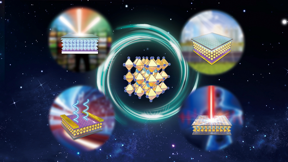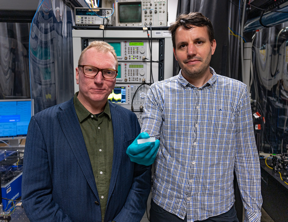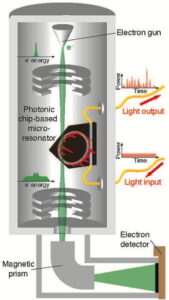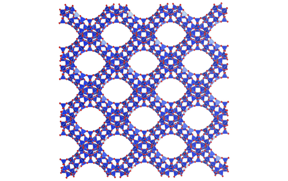Home > Press > Metal halide perovskite for next-generation optoelectronics: Progresses and prospects
 |
| Metal halide perovskites under the spotlight: Game changer for next generation optoelectronics. CREDIT by He Dong, Chenxin Ran, Weiyin Gao, Mingjie Li, Yingdong Xia, Wei Huang |
Abstract:
Metal halide perovskites (MHPs) have been emerging as the rising star in the field of optoelectronics during the past decade. The state-of-the-art optoelectronic technologies based on MHPs, such as perovskite solar cells (PSCs), light emitting diodes (LEDs), photodetectors (PDs) and lasers, have been leading the prevailing paradigm owing to the intriguing optoelectronic properties of MHPs. Also, MHPs possesses the merits of facile and low-cost processing and the favorable tunable optical and electronic features, providing a rich and fertile ground for the development of high-performing multifunctional optoelectronic devices and their future industrialization.
Metal halide perovskite for next-generation optoelectronics: Progresses and prospects
Changchun, China | Posted on January 6th, 2023In a new paper published in eLight, a team of scientists led by Professor Wei Huang from Frontiers Science Center for Flexible Electronics, Xi’an Institute of Flexible Electronics, Northwestern Polytechnical University, China, Key Laboratory of Flexible Electronics & Institution of Advanced Materials, Nanjing Tech University, China, Key Laboratory for Organic Electronics & Information Displays, and Institute of Advanced Materials, Nanjing University of Posts and Telecommunications, and co-workers have given a panorama picture on the optoelectronic traits of MHPs and their revolutionary impact on the next-generation optoelectronics. They first retrospect the historical research milestones of MHPs and their optoelectronic devices. Thereafter, they introduce the origin of the unique optoelectronic features of MHPs, based on which the tunability of these features via regulating the phase, dimensionality, composition, and geometry of MHPs are highlighted. Then, they show that owing to the convenient property control of MHPs, various optoelectronic devices with target performance can be designed. At last, they emphasize on the revolutionary applications of MHPs-based devices on the existing optoelectronic systems. This perspective aims at providing critical guidance for inspiring the novel research directions of MHPs to promote the widespread application of MHPs in optoelectronics.
The unique characteristics of MHPs are derived from their crystal structure and chemical composition, which allows the unprecedented flexibility to independently and synergistically tune the optoelectronic properties of MHPs, laying an important foundation for MHPs being applicable to various optoelectronic applications, including solar cells, LEDs, PDs and lasers. These scientists highlight the unique optoelectronic properties of MHPs:
“Of critical importance, intrinsic electronic configurations of MHPs are the direct origin of their unique optoelectronic properties, including high optical absorption, high carrier mobility, high defect tolerances, long diffusion lengths, unique ambipolar charge transport, and flexible turnability. We summarize the merits of MHPs by focusing on the fine controlling of the optoelectronic properties by regulating the structure of MHPs, including phase, dimensionality, composition, and geometry”
“MHPs are expected to make indispensable contribution to the advanced revolutionary technologies that could benefit the mankind, such as functional integration system, information display system, electronic communication system, and health & medical system.” they added.
“Metal halide perovskites (MHPs), emerging as innovative and promising semiconductor materials with prominent optoelectronic properties, has been pioneering a new era of light management (ranging from emission, absorption, modulation, to transmission) for next-generation optoelectronic technology. Nevertheless, to promote the large-scale utilization of MHPs, there are still many technique problems to be overcome, such as stability and toxicity issues, and vast investments are required to establish the building of MHPs-based optoelectronics. Overall, one can expect that in the next decade, MHPs will be under the spotlight in the era of “light”.” the scientists forecast.
####
For more information, please click here
Contacts:
Media Contact
Yaobiao Li
Light Publishing Center, Changchun Institute of Optics, Fine Mechanics And Physics, CAS
Office: 86-431-861-76851
Expert Contact
Chenxin Ran
Northwestern Polytechnical University, China
Copyright © Light Publishing Center, Changchun Institute of Optics, Fine Mechanics And Physics, CAS
If you have a comment, please Contact us.Issuers of news releases, not 7th Wave, Inc. or Nanotechnology Now, are solely responsible for the accuracy of the content.
| Related Links |
| Related News Press |
- SEO Powered Content & PR Distribution. Get Amplified Today.
- Platoblockchain. Web3 Metaverse Intelligence. Knowledge Amplified. Access Here.
- Source: http://www.nanotech-now.com/news.cgi?story_id=57268
- 10
- a
- accuracy
- added
- advanced
- Advanced materials
- aims
- allows
- and
- applicable
- Application
- applications
- based
- being
- benefit
- Building
- Cells
- Center
- Changer
- characteristics
- charge
- chemical
- China
- COM
- comment
- Communication
- content
- contribution
- control
- controlling
- Convenient
- could
- credit
- critical
- Crystal
- decade
- Derived
- designed
- Development
- Devices
- direct
- Display
- displays
- during
- Electronic
- Electronics
- emerging
- emission
- emphasize
- Era
- establish
- Ether (ETH)
- existing
- expect
- expected
- Features
- field
- fine
- First
- Flexibility
- flexible
- focusing
- Forecast
- Foundation
- from
- Frontiers
- functional
- future
- game
- game-changer
- GAO
- generation
- geometry
- gif
- given
- Ground
- Health
- High
- high-performing
- Highlight
- Highlighted
- historical
- HTTPS
- Impact
- importance
- important
- in
- Inc.
- Including
- independently
- information
- innovative
- inspiring
- Institute
- Institution
- integration
- intrinsic
- introduce
- Investments
- issues
- January
- Key
- laboratory
- large-scale
- lasers
- Last
- leading
- Led
- light
- links
- Long
- make
- management
- mankind
- many
- materials
- mechanics
- medical
- metal
- Milestones
- mobility
- more
- nanjing
- nanotechnology
- net
- Nevertheless
- New
- news
- next
- next-generation
- novel
- ONE
- optics
- organic
- Origin
- overall
- Overcome
- Paper
- paradigm
- past
- PDS
- performance
- perspective
- phase
- PHP
- Physics
- picture
- Pioneering
- plato
- Plato Data Intelligence
- PlatoData
- please
- Post
- posted
- Posts
- problems
- processing
- Professor
- prominent
- promising
- promote
- properties
- property
- prospects
- providing
- published
- Publishing
- ranging
- Releases
- required
- research
- responsible
- return
- revolutionary
- Rich
- rising
- Save
- Science
- scientists
- Search
- semiconductor
- Share
- show
- solar
- Solar cells
- Spotlight
- Stability
- Star
- start
- state-of-the-art
- Still
- structure
- submit
- such
- summarize
- system
- Systems
- Target
- team
- tech
- Technologies
- Technology
- telecommunications
- The
- their
- to
- transport
- under
- unique
- university
- unprecedented
- us
- various
- Vast
- via
- Wave
- which
- widespread
- will
- Yahoo
- zephyrnet





















